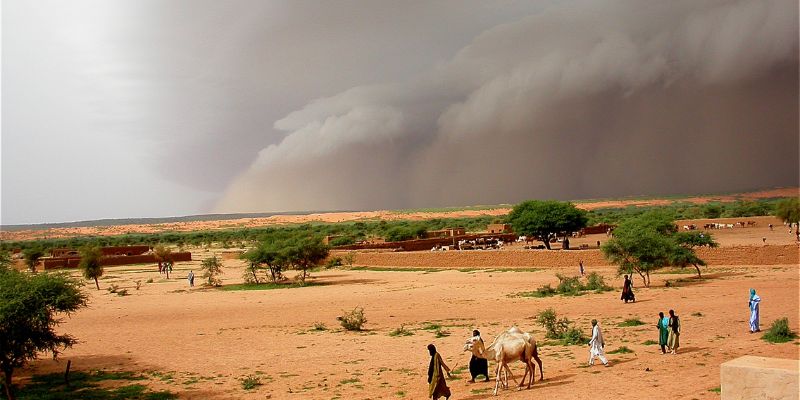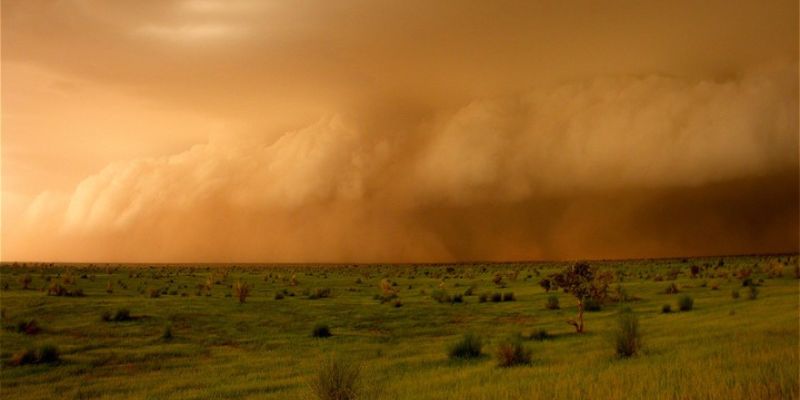
Large contrasts in soil moisture levels over a wide area can increase the size and intensity of so-called megastorms which cause flooding and mudslides in hotspots across the globe.
Researchers from the University of Leeds School of Earth and Environment have contributed to a groundbreaking study which could transform early warning systems in tropical regions where flash flooding threatens lives and property.
The research led by the UK Centre for Ecology and Hydrology (UKCEH) focused on organised clusters of thunderstorms called mesoscale convective systems, which bring severe flash flooding and mudslides in parts of Africa, Asia, the Americas and Australia – areas which collectively have a population of nearly four billion people.
These weather systems, which can be larger in size than England and travel hundreds of kilometres, bring intense storms that kill people and livestock, as well as destroying homes, infrastructure and livelihoods.
Intensification of storms by these soil moisture feedbacks adds to the impact of climate change on communities which are already vulnerable.
The study which has been published today (4 April) in Nature Geoscience, reveals that large contrasts in soil moisture levels over a range of hundreds of kilometres can increase the amount of rainfall and the area which it covers by up to 30% depending on the region and the size of the storm.
Soil moisture
The team in Leeds explored the ways in which winds, temperature and humidity patterns in different climatic regions influenced the patterns of storm response to soil moisture.
They found that storms consistently responded to the state of the land surface over a diverse range of climates, but the relationship with wind patterns in particular is dependent on the latitude and the large-scale climate of the region.
Areas, such as the monsoon regions, where there are strong contrasts in horizontal temperatures are also characterised by strong variations of vertical winds which can intensify storms.
Co-author John Marsham, Professor of Atmospheric Science in the School of Earth and Environment, said: “The study reveals how properties of the land surface can control winds and so intensify large, organised complexes of thunderstorms, with robust results across global storm hot-spot regions.
“Climate change is making storms stronger, and this is going to get worse in the coming years. This study provides important new evidence of what weather and climate models must capture to provide accurate and reliable predictions.”

The effects of flash flooding on a community near Lusaka in Zambia. Picture courtesy of Katharine Vincent.
Storm forecasting is traditionally based on studying atmospheric conditions, but this new research also looks at land surface conditions. This will improve early warning systems, enabling communities to better adapt to the destructive impacts of climate change.
Early warning
The researchers found surface conditions that influence rainfall can be observed two to five days before a storm hits, which will allow advance warning of potential flash flooding.
Early warning allows people to move themselves, their families, livestock, vehicles and possessions to upland areas, or to clear blocked drains in advance of storms to limit surface water flooding, for example.
Douglas Parker, a Professor of Meteorology in the School of Earth and Environment and a co-author of the paper, explained: “In many parts of the world, the rainfall from these storms is vital for farming. But when the storms become extreme, they instead become a significant hazard to agriculture, property and life, bringing flash floods, lightning and high winds. Intensification of storms by these soil moisture feedbacks adds to the impact of climate change on communities which are already vulnerable.
“These storms are notoriously hard to forecast, as they grow and move quite unpredictably, sometimes over only an hour or so. Understanding how their movement is influenced by the underlying land surface and by the wind patterns in the environment will enable us to give people better warnings of impending impacts, perhaps six hours in advance.”
Destructive storms
Last year Africa was reported to have had its worst storm season in several years. Between June and September, severe flooding in West and Central Africa, linked to heavy rainfall, killed a total of over 1,000 people, displaced more than 500,000 and destroyed over 300,000 homes.
In Argentina, a severe storm in March killed 13 people, displaced over 1,000, swept cars away and destroyed roads and bridges.
In Bengal, India, in March 2024, a thunderstorm damaged around 800 homes, injured 300 people and killed five.
And in just the last few days, storms and tornadoes in the USA have killed at least seven people and caused widespread disruption, with over 200,000 households without power, a state of emergency declared, and further heavy rainfall and flooding expected.

A storm in Mali. Picture by Francoise Guichard.
The new study involved a detailed analysis of 20 years of satellite data relating to storm activity and soil moisture conditions in West Africa, Southern Africa, India, South America, as well as computer modelling.
The researchers found that a greater contrast in moisture between wetter and drier areas over a large distance resulted in a greater contrast in air temperatures. This led to stronger shifts in wind direction and/or speed higher up in the atmosphere. This helps storms to grow, producing more rainfall over a larger area.
Global impacts
In addition to their analysis in West and Southern Africa, India and South America, the researchers observed the same connection between soil moisture contrasts and wind circulations in China, Australia and the US Great Plains. While there were insufficient storm data to carry out a full analysis, they are confident that soil moisture contrasts are also exacerbating rainfall in other regions affected by mesoscale convective systems.
The next step for the researchers is to explore what factors contribute to these regional variations. They are also using the latest, advanced climate models, which better incorporate storms, to improve understanding of the processes that make rainfall more intense as temperatures continue to rise under global warming.
Lead author Dr Emma Barton, a meteorologist at the UK Centre for Ecology and Hydrology (UKCEH), added: “Mesoscale convective systems are some of the most intense thunderstorms on the planet, and are increasing in severity due to climate change. Rising temperatures could increase the contrast between wet and dry areas of soils, further intensifying thunderstorms in already severely impacted regions.
“Understanding how soil moisture influences storm activity, and how this may change in the future, will be essential for more accurate short-term forecasting to warn communities about approaching storms, as well as making longer-term projections.”
Further information
For media enquiries, please contact Kersti Mitchell via k.mitchell@leeds.ac.uk
The new study is part of ongoing UKCEH research funded by the Natural Environment Research Council (NERC).